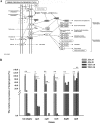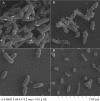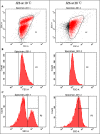Comparative Transcriptome Analysis of Vibrio splendidus JZ6 Reveals the Mechanism of Its Pathogenicity at Low Temperatures
- PMID: 26801576
- PMCID: PMC4807526
- DOI: 10.1128/AEM.03486-15
Comparative Transcriptome Analysis of Vibrio splendidus JZ6 Reveals the Mechanism of Its Pathogenicity at Low Temperatures
Abstract
Yesso scallop-pathogenic Vibrio splendidus strain JZ6 was found to have the highest virulence at 10°C, while its pathogenicity was significantly reduced with increased temperature and completely incapacitated at 28°C. In the present study, comparative transcriptome analyses of JZ6 and another nonpathogenic V. splendidus strain, TZ19, were conducted at two crucial culture temperatures (10°C and 28°C) in order to determine the possible mechanism of temperature regulation of virulence. Comparisons among four libraries, constructed from JZ6 and TZ19 cultured at 10°C and 28°C (designated JZ6_10, JZ6_28, TZ19_10, and TZ19_28), revealed that 241 genes were possibly related to the increased virulence of JZ6 at 10°C. There were 10 genes, including 2 encoding Flp pilus assembly proteins (FlhG and VS_2437), 6 encoding proteins of the "Vibrio cholerae pathogenic cycle" (ToxS, CqsA, CqsS, RpoS, HapR, and Vsm), and 2 encoding proteins in the Sec-dependent pathway (SecE and FtsY), that were significantly upregulated in JZ6_10 (P < 0.05) compared to those in JZ6_28, TZ19_10, and TZ19_28, which were supposed to be responsible for adhesion, quorum sensing, virulence, and protein secretion of V. splendidus. When cultured at 10°C, JZ6 cells were larger and tended to aggregate more than those cultured at 28°C. The virulence factor (extracellular metalloprotease) was also found to be highly expressed in the extracellular product (ECP) of JZ6 at 10°C, and this ECP exhibited obvious cytotoxicity to oyster primary hemocytes, A549 cells, and L929 cells. These results indicated that low temperatures (10°C) could enhance adhesion, activate the quorum sensing systems, upregulate virulence factor synthesis and secretion, and, lastly, increase the pathogenicity of JZ6.
Copyright © 2016, American Society for Microbiology. All Rights Reserved.
Figures









Similar articles
-
Identification and characterisation of pathogenic Vibrio splendidus from Yesso scallop (Patinopecten yessoensis) cultured in a low temperature environment.J Invertebr Pathol. 2013 Oct;114(2):144-50. doi: 10.1016/j.jip.2013.07.005. Epub 2013 Jul 30. J Invertebr Pathol. 2013. PMID: 23911357
-
Evidence for Cleavage of the Metalloprotease Vsm from Vibrio splendidus Strain JZ6 by an M20 Peptidase (PepT-like Protein) at Low Temperature.Front Microbiol. 2016 Oct 25;7:1684. doi: 10.3389/fmicb.2016.01684. eCollection 2016. Front Microbiol. 2016. PMID: 27826294 Free PMC article.
-
The sensing pattern and antitoxic response of Crassostrea gigas against extracellular products of Vibrio splendidus.Dev Comp Immunol. 2020 Jan;102:103467. doi: 10.1016/j.dci.2019.103467. Epub 2019 Aug 16. Dev Comp Immunol. 2020. PMID: 31425720
-
A sigma factor RpoD negatively regulates temperature-dependent metalloprotease expression in a pathogenic Vibrio splendidus.Microb Pathog. 2019 Mar;128:311-316. doi: 10.1016/j.micpath.2019.01.021. Epub 2019 Jan 17. Microb Pathog. 2019. PMID: 30660738
-
Fitness factors in vibrios: a mini-review.Microb Ecol. 2013 May;65(4):826-51. doi: 10.1007/s00248-012-0168-x. Epub 2013 Jan 10. Microb Ecol. 2013. PMID: 23306394 Review.
Cited by
-
Survival Characteristics and Transcriptomic Analyses Reveal the Adaptive Response of the Aquatic Pathogen Non-O1/O139 Vibrio cholerae to Starvation Stress.Microbiol Spectr. 2022 Jun 29;10(3):e0193921. doi: 10.1128/spectrum.01939-21. Epub 2022 May 9. Microbiol Spectr. 2022. PMID: 35532354 Free PMC article.
-
New Insights into Pathogenic Vibrios Affecting Bivalves in Hatcheries: Present and Future Prospects.Front Microbiol. 2017 May 3;8:762. doi: 10.3389/fmicb.2017.00762. eCollection 2017. Front Microbiol. 2017. PMID: 28515714 Free PMC article. Review.
-
Characterization and potential mechanisms of highly antibiotic tolerant VBNC Escherichia coli induced by low level chlorination.Sci Rep. 2020 Feb 6;10(1):1957. doi: 10.1038/s41598-020-58106-3. Sci Rep. 2020. PMID: 32029755 Free PMC article.
-
Isolation and Characterization of Vibrio kanaloae as a Major Pathogen Associated with Mass Mortalities of Ark Clam, Scapharca broughtonii, in Cold Season.Microorganisms. 2021 Oct 16;9(10):2161. doi: 10.3390/microorganisms9102161. Microorganisms. 2021. PMID: 34683482 Free PMC article.
-
Characterization of Vibrio mediterranei Isolates as Causative Agents of Vibriosis in Marine Bivalves.Microbiol Spectr. 2023 Feb 2;11(2):e0492322. doi: 10.1128/spectrum.04923-22. Online ahead of print. Microbiol Spectr. 2023. PMID: 36728415 Free PMC article.
References
-
- Lacoste A, Jalabert F, Malham S, Cueff A, Gélébart F, Cordevant C, Lange M, Poulet SA. 2001. A Vibrio splendidus strain is associated with summer mortality of juvenile oysters Crassostrea gigas in the Bay of Morlaix (North Brittany, France). Dis Aquat Organ 46:139–145. doi:10.3354/dao046139. - DOI - PubMed
-
- Liu R, Qiu L, Yu Z, Zi J, Yue F, Wang L, Zhang H, Teng W, Liu X, Song L. 2013. Identification and characterisation of pathogenic Vibrio splendidus from Yesso scallop (Patinopecten yessoensis) cultured in a low temperature environment. J Invertebr Pathol 114:144–150. doi:10.1016/j.jip.2013.07.005. - DOI - PubMed
Publication types
MeSH terms
Substances
LinkOut - more resources
Full Text Sources
Other Literature Sources

